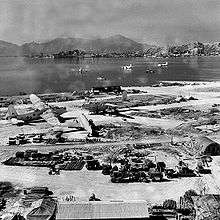No. 215 Squadron RAF
| No. 215 Squadron RAF | |
|---|---|
| Active |
1918–1919 1935–1940 1940–1946 1947–1948 1963–1967 |
| Country | United Kingdom |
| Branch | Royal Air Force |
| Motto(s) |
Surgite nox adest Latin: "Arise, night is at hand" |
| Equipment |
Vickers Wellington Consolidated Liberator Douglas Dakota |
No. 215 Squadron was a Royal Air Force aircraft squadron formed as a night bomber squadron in World War I and again in World War II, becoming a transport squadron near the end of the Second World War.
History
No. 215 Squadron RAF was formed in France on 1 April 1918 by renumbering No. 15 squadron of the Royal Naval Air Service. No. 15 Squadron RNAS had been formed on 10 March 1918 to operate the Handley Page 0/100 as a night bomber squadron against targets in Germany. Soon after the squadron became part of the Royal Air Force it returned to England to re-equip with the Handley Page O/400 before returning to France as part of the Independent Air Force. After World War I hostilities ended (November 1918), the squadron disbanded on 18 October 1919.
The squadron was reformed on 1 October 1935 from 'A' flight of No. 58 Squadron at RAF Worthy Down. It was merged into 11 OTU. The squadron re-formed at RAF Honington on the same day with the Vickers Wellington only to be merged into 11 OTU the following month.
The squadron was reformed in December 1941 at RAF Newmarket ready for movement to India. The squadron was posted to Calcutta in 1942 and was involved in bombing operations using first Vickers Wellington and then later, Consolidated Liberator aircraft.
In April 1945 it re-equipped with the Douglas Dakota and assumed a transport squadron role for the remainder of the war. The squadron disbanded on 15 February 1946 and was renumbered No. 48 Squadron.
The squadron was formed again on 1 August 1947 at Kabrit in Egypt with the Douglas Dakota for transport duties and was disbanded on 1 May 1948 when it was re-numbered as 70 Squadron.
The squadron was reformed in April 1956 at RAF Dishforth to operate the Scottish Aviation Pioneer in the light transport role and Army support duties, and was disbanded two years later in September 1958 when it was re-numbered as 230 Squadron.
The squadron was again formed in May 1963 at RAF Benson as a medium-range transport squadron for operation in the Far East and it moved to RAF Changi with the Armstrong Whitworth Argosy until it was disbanded in December 1967.
Aircraft operated

| Dates | Aircraft | Variant | Notes |
|---|---|---|---|
| 1918 | Handley Page O/100 | Twin-engined biplane bomber | |
| 1918–1919 | Handley Page O/400 | Twin-engined biplane heavy bomber | |
| 1935–1937 | Vickers Virginia | X | Twin-engined biplane heavy bomber |
| 1937 1940 |
Avro Anson | I | |
| 1937–1939 | Handley Page Harrow | Twin-engined heavy bomber | |
| 1939–1940 | Vickers Wellington | I and IA | Twin-engined medium bomber |
| 1942–1943 1943–1944 |
Vickers Wellington | IC X |
|
| 1944–1945 | Consolidated Liberator | VI | Four-engined heavy bomber |
| 1945–1946 1947–1948 |
Douglas Dakota | Twin-engined transport | |
| 1956–1958 | Scottish Aviation Pioneer | CC1 | Twin-engined light transport |
| 1963–1967 | Armstrong Whitworth Argosy | C1 | Four-engined medium transport |
References
Notes
- ↑ Jefford 1988, page 71
Bibliography
- Gwynne-Timothy, John R.W. Burma Liberators: RCAF in SEAC. Toronto, Ontario, Canada: Next Level Press, 1991. ISBN 1-895578-02-7.
- Jefford, Wing Commander C.G. (2001). RAF Squadrons, a Comprehensive record of the Movement and Equipment of all RAF Squadrons and their Antecedents since 1912. Shrewsbury, Shropshire, UK: Airlife Publishing Ltd. ISBN 1-85310-053-6.
External links
| Wikimedia Commons has media related to No. 215 Squadron RAF. |